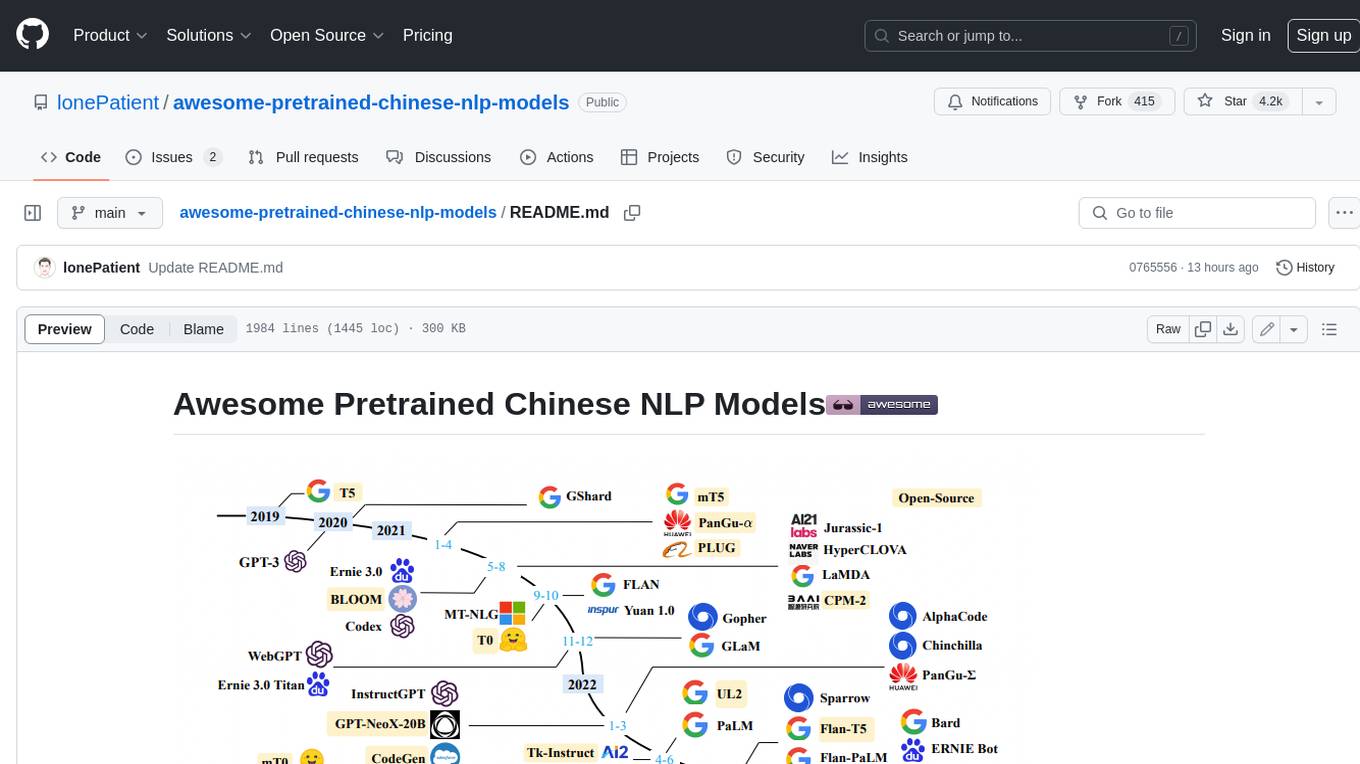
PaddleScience
PaddleScience is SDK and library for developing AI-driven scientific computing applications based on PaddlePaddle.
Stars: 305
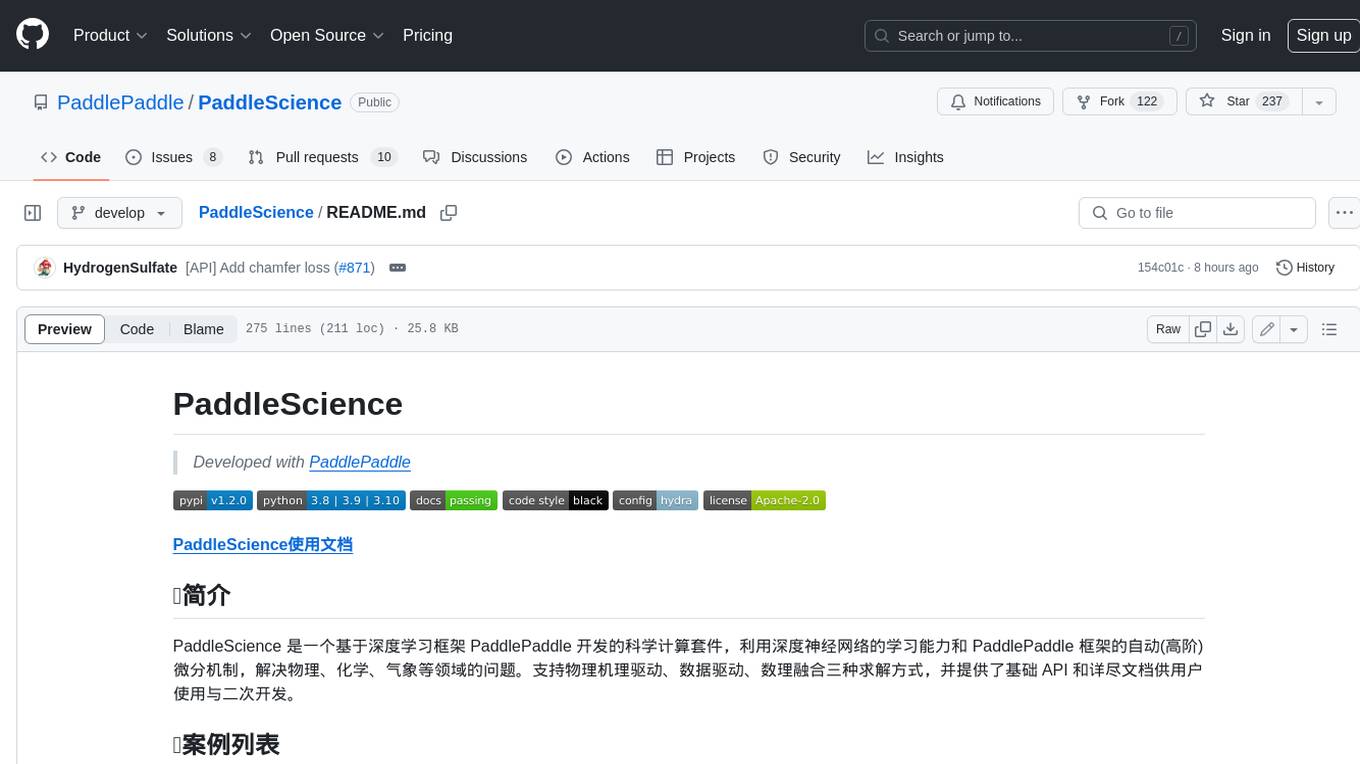
PaddleScience is a scientific computing suite developed based on the deep learning framework PaddlePaddle. It utilizes the learning ability of deep neural networks and the automatic (higher-order) differentiation mechanism of PaddlePaddle to solve problems in physics, chemistry, meteorology, and other fields. It supports three solving methods: physics mechanism-driven, data-driven, and mathematical fusion, and provides basic APIs and detailed documentation for users to use and further develop.
README:
Developed with PaddlePaddle
📘 使用文档 | 🛠️ 安装使用 | 📘 快速开始 | 👀 案例列表 | 🆕 最近更新 | 🤔 问题反馈
🔥 飞桨AI for Science前沿讲座系列课程 & 代码入门与实操课程进行中 ,清华、北大、中科院等高校机构知名学者分享前沿研究成果,火热报名中。
🔥 开放原子第二届开源大赛:飞桨科学计算工具组件开发大赛,总奖金25万人民币,火热报名中
🔥 PaddlePaddle Hackathon 7th 开源贡献个人挑战赛
🔥 CIKM 2024: AI辅助的先进空气动力学-优化汽车设计以实现最佳性能,已进入评奖阶段。
🔥 IJCAI 2024: 任意三维几何外形车辆的风阻快速预测竞赛,track A, B, C 代码: paddle实现 | pytorch实现(点击排行榜可查看各个赛道前10名的代码)
PaddleScience 是一个基于深度学习框架 PaddlePaddle 开发的科学计算套件,利用深度神经网络的学习能力和 PaddlePaddle 框架的自动(高阶)微分机制,解决物理、化学、气象等领域的问题。支持物理机理驱动、数据驱动、数理融合三种求解方式,并提供了基础 API 和详尽文档供用户使用与二次开发。
数学(AI for Math)
| 问题类型 | 案例名称 | 优化算法 | 模型类型 | 训练方式 | 数据集 | 参考资料 |
|---|---|---|---|---|---|---|
| 亥姆霍兹方程 | SPINN(Helmholtz3D) | 机理驱动 | SPINN | 无监督学习 | - | Paper |
| 相场方程 | Allen-Cahn | 机理驱动 | MLP | 无监督学习 | Data | Paper |
| 微分方程 | 拉普拉斯方程 | 机理驱动 | MLP | 无监督学习 | - | - |
| 微分方程 | 伯格斯方程 | 机理驱动 | MLP | 无监督学习 | Data | Paper |
| 微分方程 | 非线性偏微分方程 | 机理驱动 | PIRBN | 无监督学习 | - | Paper |
| 微分方程 | 洛伦兹方程 | 数据驱动 | Transformer-Physx | 监督学习 | Data | Paper |
| 微分方程 | 若斯叻方程 | 数据驱动 | Transformer-Physx | 监督学习 | Data | Paper |
| 算子学习 | DeepONet | 数据驱动 | MLP | 监督学习 | Data | Paper |
| 微分方程 | 梯度增强的物理知识融合 PDE 求解 | 机理驱动 | gPINN | 无监督学习 | - | Paper |
| 积分方程 | 沃尔泰拉积分方程 | 机理驱动 | MLP | 无监督学习 | - | Project |
| 微分方程 | 分数阶微分方程 | 机理驱动 | MLP | 无监督学习 | - | - |
| 光孤子 | Optical soliton | 机理驱动 | MLP | 无监督学习 | - | Paper |
| 光纤怪波 | Optical rogue wave | 机理驱动 | MLP | 无监督学习 | - | Paper |
| 域分解 | XPINN | 机理驱动 | MLP | 无监督学习 | - | Paper |
| 布鲁塞尔扩散系统 | 3D-Brusselator | 数据驱动 | LNO | 监督学习 | - | Paper |
| 符号回归 | Transformer4SR | 数据驱动 | Transformer | 监督学习 | - | Paper |
技术科学(AI for Technology)
| 问题类型 | 案例名称 | 优化算法 | 模型类型 | 训练方式 | 数据集 | 参考资料 |
|---|---|---|---|---|---|---|
| 一维线性对流问题 | 1D 线性对流 | 数据驱动 | ViT | 监督学习 | Data | Paper |
| 非定常不可压流体 | 2D 方腔浮力驱动流 | 数据驱动 | ViT | 监督学习 | Data | Paper |
| 定常不可压流体 | Re3200 2D 定常方腔流 | 机理驱动 | MLP | 无监督学习 | - | |
| 定常不可压流体 | 2D 达西流 | 机理驱动 | MLP | 无监督学习 | - | |
| 定常不可压流体 | 2D 管道流 | 机理驱动 | MLP | 无监督学习 | - | Paper |
| 定常不可压流体 | 3D 颅内动脉瘤 | 机理驱动 | MLP | 无监督学习 | Data | Project |
| 定常不可压流体 | 任意 2D 几何体绕流 | 数据驱动 | DeepCFD | 监督学习 | - | Paper |
| 非定常不可压流体 | 2D 非定常方腔流 | 机理驱动 | MLP | 无监督学习 | - | - |
| 非定常不可压流体 | Re100 2D 圆柱绕流 | 机理驱动 | MLP | 半监督学习 | Data | Paper |
| 非定常不可压流体 | Re100~750 2D 圆柱绕流 | 数据驱动 | Transformer-Physx | 监督学习 | Data | Paper |
| 可压缩流体 | 2D 空气激波 | 机理驱动 | PINN-WE | 无监督学习 | - | Paper |
| 飞行器设计 | MeshGraphNets | 数据驱动 | GNN | 监督学习 | Data | Paper |
| 飞行器设计 | 火箭发动机真空羽流 | 数据驱动 | CNN | 监督学习 | Data | - |
| 飞行器设计 | Deep-Flow-Prediction | 数据驱动 | TurbNetG | 监督学习 | Data | Paper |
| 通用流场模拟 | 气动外形设计 | 数据驱动 | AMGNet | 监督学习 | Data | Paper |
| 流固耦合 | 涡激振动 | 机理驱动 | MLP | 半监督学习 | Data | Paper |
| 多相流 | 气液两相流 | 机理驱动 | BubbleNet | 半监督学习 | Data | Paper |
| 多相流 | twophasePINN | 机理驱动 | MLP | 无监督学习 | - | Paper |
| 流场高分辨率重构 | 2D 湍流流场重构 | 数据驱动 | tempoGAN | 监督学习 |
Train Data Eval Data |
Paper |
| 流场高分辨率重构 | 2D 湍流流场重构 | 数据驱动 | cycleGAN | 监督学习 |
Train Data Eval Data |
Paper |
| 流场高分辨率重构 | 基于Voronoi嵌入辅助深度学习的稀疏传感器全局场重建 | 数据驱动 | CNN | 监督学习 |
Data1 Data2 Data3 |
Paper |
| 流场预测 | Catheter | 数据驱动 | FNO | 监督学习 | Data | Paper |
| 求解器耦合 | CFD-GCN | 数据驱动 | GCN | 监督学习 |
Data Mesh |
Paper |
| 受力分析 | 1D 欧拉梁变形 | 机理驱动 | MLP | 无监督学习 | - | - |
| 受力分析 | 2D 平板变形 | 机理驱动 | MLP | 无监督学习 | - | Paper |
| 受力分析 | 3D 连接件变形 | 机理驱动 | MLP | 无监督学习 | Data | Tutorial |
| 受力分析 | 结构震动模拟 | 机理驱动 | PhyLSTM | 监督学习 | Data | Paper |
| 受力分析 | 2D 弹塑性结构 | 机理驱动 | EPNN | 无监督学习 |
Train Data Eval Data |
Paper |
| 受力分析和逆问题 | 3D 汽车控制臂变形 | 机理驱动 | MLP | 无监督学习 | - | - |
| 受力分析和逆问题 | 3D 心脏仿真 | 数理融合 | PINN | 监督学习 | - | - |
| 拓扑优化 | 2D 拓扑优化 | 数据驱动 | TopOptNN | 监督学习 | Data | Paper |
| 热仿真 | 1D 换热器热仿真 | 机理驱动 | PI-DeepONet | 无监督学习 | - | - |
| 热仿真 | 2D 热仿真 | 机理驱动 | PINN | 无监督学习 | - | Paper |
| 热仿真 | 2D 芯片热仿真 | 机理驱动 | PI-DeepONet | 无监督学习 | - | Paper |
材料科学(AI for Material)
| 问题类型 | 案例名称 | 优化算法 | 模型类型 | 训练方式 | 数据集 | 参考资料 |
|---|---|---|---|---|---|---|
| 材料设计 | 散射板设计(反问题) | 数理融合 | 数据驱动 | 监督学习 |
Train Data Eval Data |
Paper |
地球科学(AI for Earth Science)
| 问题类型 | 案例名称 | 优化算法 | 模型类型 | 训练方式 | 数据集 | 参考资料 |
|---|---|---|---|---|---|---|
| 天气预报 | Extformer-MoE 气象预报 | 数据驱动 | FourCastNet | 监督学习 | enso | - |
| 天气预报 | FourCastNet 气象预报 | 数据驱动 | FourCastNet | 监督学习 | ERA5 | Paper |
| 天气预报 | NowCastNet 气象预报 | 数据驱动 | NowCastNet | 监督学习 | MRMS | Paper |
| 天气预报 | GraphCast 气象预报 | 数据驱动 | GraphCastNet | 监督学习 | - | Paper |
| 大气污染物 | UNet 污染物扩散 | 数据驱动 | UNet | 监督学习 | Data | - |
| 天气预报 | DGMR 气象预报 | 数据驱动 | DGMR | 监督学习 | UK dataset | Paper |
| 地震波形反演 | VelocityGAN 地震波形反演 | 数据驱动 | VelocityGAN | 监督学习 | OpenFWI | Paper |
- 基于 PaddleScience 的 ADR 方程求解方法 Physics-informed neural networks for advection–diffusion–Langmuir adsorption processes 被 Physics of Fluids 2024 接受。
- 添加 IJCAI 2024: 任意三维几何外形车辆的风阻快速预测竞赛,track A, B, C 的 paddle/pytorch 代码链接。
- 添加 SPINN(基于 Helmholtz3D 方程求解) helmholtz3d。
- 添加 CVit(基于 Advection 方程和 N-S 方程求解) CVit(Navier-Stokes)、CVit(Advection)。
- 添加 PirateNet(基于 Allen-cahn 方程和 N-S 方程求解) Allen-Cahn、LDC2D(Re3200)。
- 基于 PaddleScience 的快速热仿真方法 A fast general thermal simulation model based on MultiBranch Physics-Informed deep operator neural network 被 Physics of Fluids 2024 接受。
- 添加多目标优化算法 Relobralo 。
- 添加气泡流求解案例(Bubble)、机翼优化案例(DeepCFD)、热传导仿真案例(HeatPINN)、非线性短临预报模型(Nowcasting(仅推理))、拓扑优化案例(TopOpt)、矩形平板线弹性方程求解案例(Biharmonic2D)。
- 添加二维血管案例(LabelFree-DNN-Surrogate)、空气激波案例(ShockWave)、去噪网络模型(DUCNN)、风电预测模型(Deep Spatial Temporal)、域分解模型(XPINNs)、积分方程求解案例(Volterra Equation)、分数阶方程求解案例(Fractional Poisson 2D)。
- 针对串联方程和复杂方程场景,
Equation模块支持基于 sympy 的符号计算,并支持和 python 函数混合使用(#507、#505)。 -
Geometry模块和InteriorConstraint、InitialConstraint支持计算 SDF 微分功能(#539)。 - 添加 MultiTaskLearning(
ppsci.loss.mtl) 多任务学习模块,针对多任务优化(如 PINN 方法)进一步提升性能,使用方式:多任务学习指南(#493、#492)。
- 支持简单几何和复杂 STL 几何的采样与布尔运算。
- 支持包括 Dirichlet、Neumann、Robin 以及自定义边界条件。
- 支持物理机理驱动、数据驱动、数理融合三种问题求解方式。涵盖流体、结构、气象等领域 20+ 案例。
- 支持结果可视化输出与日志结构化保存。
- 完善的 type hints,用户使用和代码贡献全流程文档,经典案例 AI studio 快速体验,降低使用门槛,提高开发效率。
- 支持基于 sympy 符号计算库的方程表示与联立方程组计算。
- 更多特性正在开发中...
请在 PaddlePaddle 官网按照您的运行环境,安装 3.0-beta 或 develop 版的 PaddlePaddle。
安装完毕之后,运行以下命令,验证 Paddle 是否安装成功。
python -c "import paddle; paddle.utils.run_check()"如果出现 PaddlePaddle is installed successfully! Let's start deep learning with PaddlePaddle now. 信息,说明您已成功安装,可以继续安装 PaddleScience。
-
基础功能安装
从以下四种安装方式中,任选一种均可安装。
-
git 源码安装[推荐]
执行以下命令,从 github 上 clone PaddleScience 源代码,并以 editable 的方式安装 PaddleScience。
git clone -b develop https://github.com/PaddlePaddle/PaddleScience.git # 若 github clone 速度比较慢,可以使用 gitee clone # git clone -b develop https://gitee.com/paddlepaddle/PaddleScience.git cd PaddleScience # install paddlesci with editable mode python -m pip install -e . -i https://pypi.tuna.tsinghua.edu.cn/simple
-
pip 安装
执行以下命令以 pip 的方式安装 release / nightly build 版本的 PaddleScience。
# release python -m pip install -U paddlesci -i https://pypi.tuna.tsinghua.edu.cn/simple # nightly build # python -m pip install https://paddle-qa.bj.bcebos.com/PaddleScience/whl/latest/dist/paddlesci-0.0.0-py3-none-any.whl -i https://pypi.tuna.tsinghua.edu.cn/simple
-
conda 安装
执行以下命令以 conda 的方式安装 release / nightly build 版本的 PaddleScience。
# nightly build conda install paddlescience::paddlesci -c https://mirrors.tuna.tsinghua.edu.cn/anaconda/cloud/Paddle -c conda-forge # release # conda install paddlescience::paddlescience=1.3.0 -c https://mirrors.tuna.tsinghua.edu.cn/anaconda/cloud/Paddle -c conda-forge
-
设置 PYTHONPATH 并手动安装 requirements
如果在您的环境中,上述两种方式都无法正常安装,则可以选择本方式,在终端内将环境变量
PYTHONPATH临时设置为PaddleScience的绝对路径,如下所示。cd PaddleScience export PYTHONPATH=$PYTHONPATH:$PWD # for linux set PYTHONPATH=%cd% # for windows python -m pip install -r requirements.txt -i https://pypi.tuna.tsinghua.edu.cn/simple # manually install requirements
注:上述方式的优点是步骤简单无需安装,缺点是当环境变量生效的终端被关闭后,需要重新执行上述命令设置
PYTHONPATH才能再次使用 PaddleScience,较为繁琐。
-
-
验证安装
python -c "import ppsci; ppsci.utils.run_check()"
-
开始使用
import ppsci # write your code here...
如需基于复杂几何文件(*.stl, *.mesh, *.obj)文件进行训练、测试等流程,请参考完整安装流程:安装与使用
请参考 快速开始
除 PaddleScience 外,Paddle 框架同时支持了科学计算领域相关的研发套件和基础工具:
| 工具 | 简介 | 支持情况 |
|---|---|---|
| Modulus-sym | AI仿真套件 | 全量支持 |
| DeepXDE | 方程求解套件 | 全量支持 |
| DeepMD-kit | 分子动力学套件 | 部分支持 |
| TensorLy | 张量计算库 | 全量支持 |
| NVIDIA/warp | 高性能仿真/图形库 | 全量支持 |
| DLPACK(v0.8) | 跨框架张量内存共享协议 | 全量支持 |
如使用过程中遇到问题或想提出开发建议,欢迎在 Discussion 提出建议,或者在 Issue 页面新建 issue,会有专业的研发人员进行解答。
PaddleScience 项目欢迎并依赖开发人员和开源社区中的用户,会不定期推出开源活动。
在开源活动中如需使用 PaddleScience 进行开发,可参考 PaddleScience 开发与贡献指南 以提升开发效率和质量。
-
🔥第七期黑客松
面向全球开发者的深度学习领域编程活动,鼓励开发者了解与参与飞桨深度学习开源项目。活动进行中:PaddlePaddle Hackathon 7th 开源贡献个人挑战赛
-
🎁快乐开源
旨在鼓励更多的开发者参与到飞桨科学计算社区的开源建设中,帮助社区修复 bug 或贡献 feature,加入开源、共建飞桨。了解编程基本知识的入门用户即可参与,活动进行中: PaddleScience 快乐开源活动表单
PaddleScience 作为一个开源项目,欢迎来各行各业的伙伴携手共建基于飞桨的 AI for Science 领域顶尖开源项目, 打造活跃的前瞻性的 AI for Science 开源社区,建立产学研闭环,推动科研创新与产业赋能。点击了解 飞桨AI for Science共创计划。
- PaddleScience 的部分模块和案例设计受 NVIDIA-Modulus、DeepXDE、PaddleNLP、PaddleClas 等优秀开源套件的启发。
- PaddleScience 的部分案例和代码由以下优秀社区开发者贡献,(完整的贡献者请参考: Contributors): Asthestarsfalll, co63oc, MayYouBeProsperous, AndPuQing, lknt, mrcangye, yangguohao, ooooo-create, megemini, DUCH714, zlynna, jjyaoao, jiamingkong, Liyulingyue, DrRyanHuang, zbt78, Gxinhu, XYM, xusuyong, DrownFish19, NKNaN, ruoyunbai, sanbuphy, ccsuzzh, enkilee, GreatV ...
For Tasks:
Click tags to check more tools for each tasksFor Jobs:
Alternative AI tools for PaddleScience
Similar Open Source Tools

PaddleScience
PaddleScience is a scientific computing suite developed based on the deep learning framework PaddlePaddle. It utilizes the learning ability of deep neural networks and the automatic (higher-order) differentiation mechanism of PaddlePaddle to solve problems in physics, chemistry, meteorology, and other fields. It supports three solving methods: physics mechanism-driven, data-driven, and mathematical fusion, and provides basic APIs and detailed documentation for users to use and further develop.
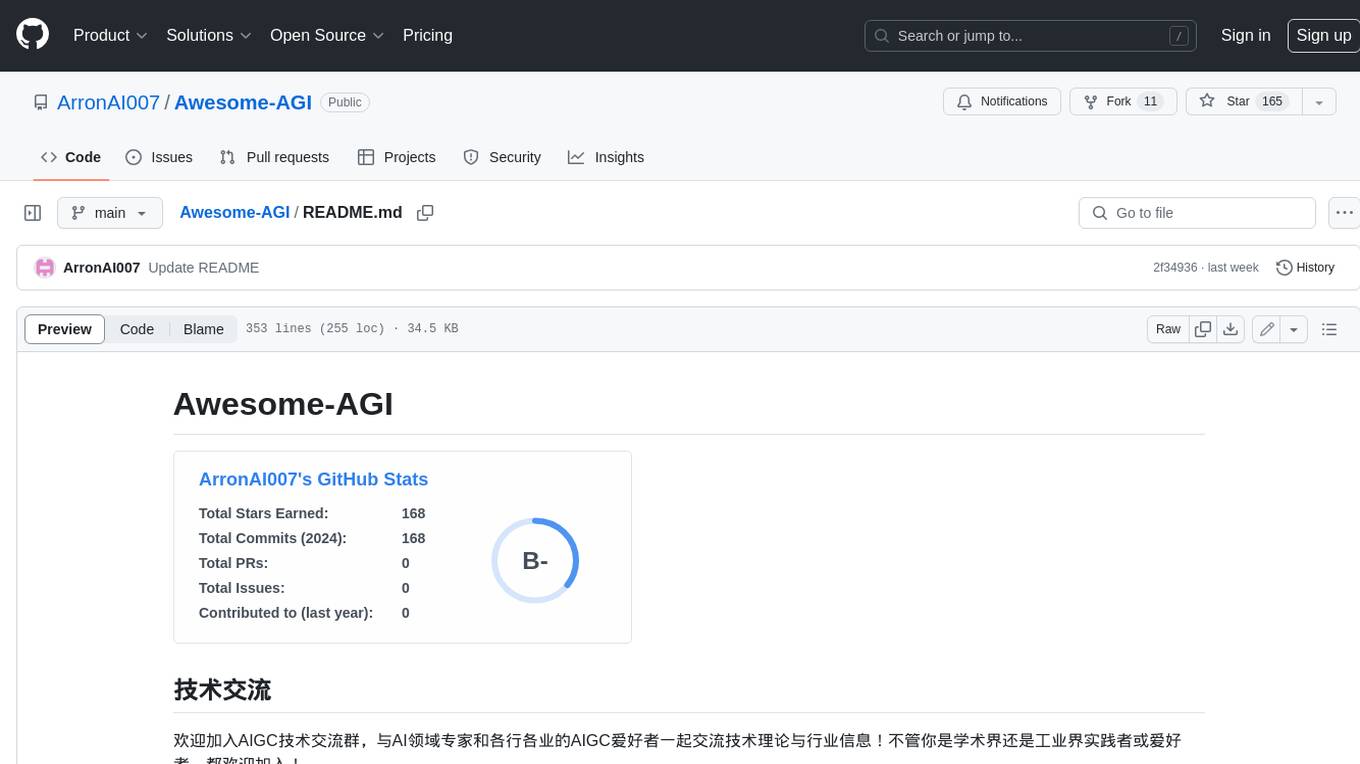
Awesome-AGI
Awesome-AGI is a curated list of resources related to Artificial General Intelligence (AGI), including models, pipelines, applications, and concepts. It provides a comprehensive overview of the current state of AGI research and development, covering various aspects such as model training, fine-tuning, deployment, and applications in different domains. The repository also includes resources on prompt engineering, RLHF, LLM vocabulary expansion, long text generation, hallucination mitigation, controllability and safety, and text detection. It serves as a valuable resource for researchers, practitioners, and anyone interested in the field of AGI.
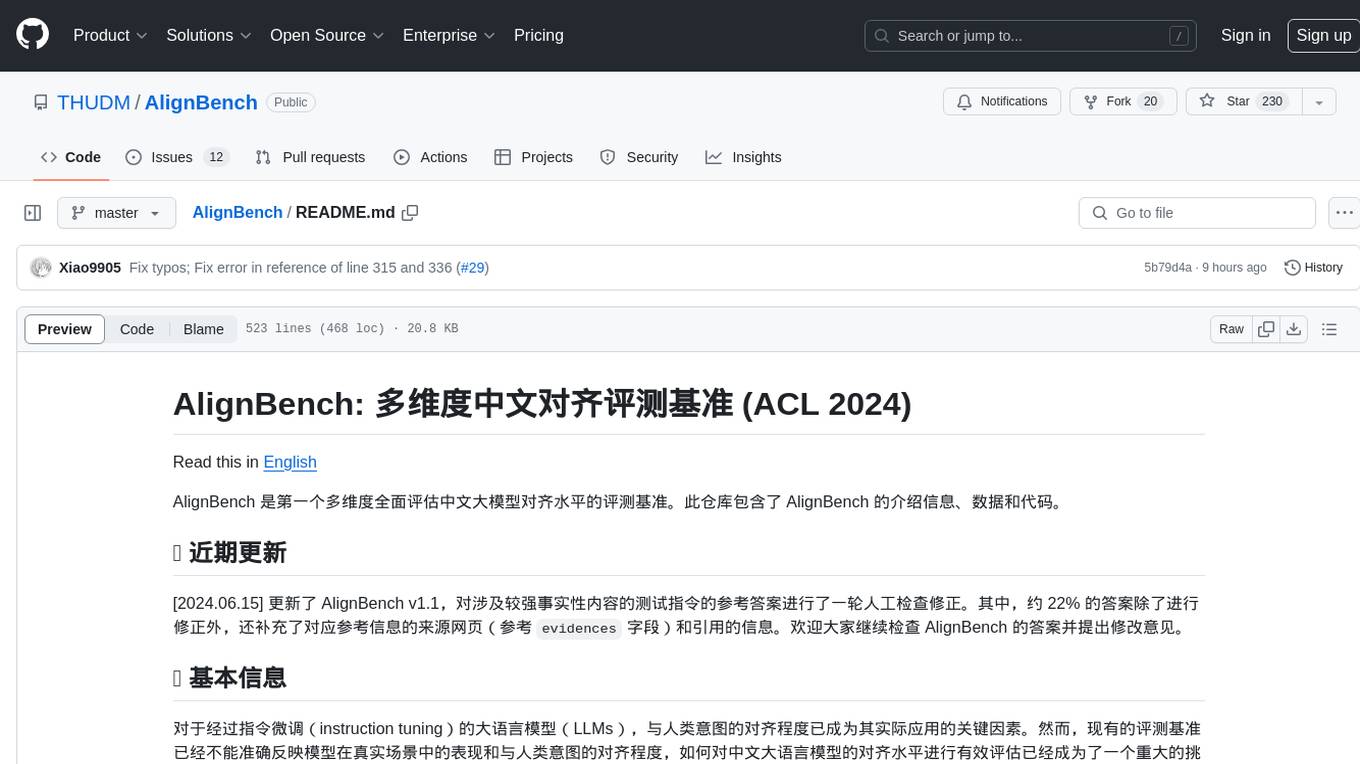
AlignBench
AlignBench is the first comprehensive evaluation benchmark for assessing the alignment level of Chinese large models across multiple dimensions. It includes introduction information, data, and code related to AlignBench. The benchmark aims to evaluate the alignment performance of Chinese large language models through a multi-dimensional and rule-calibrated evaluation method, enhancing reliability and interpretability.
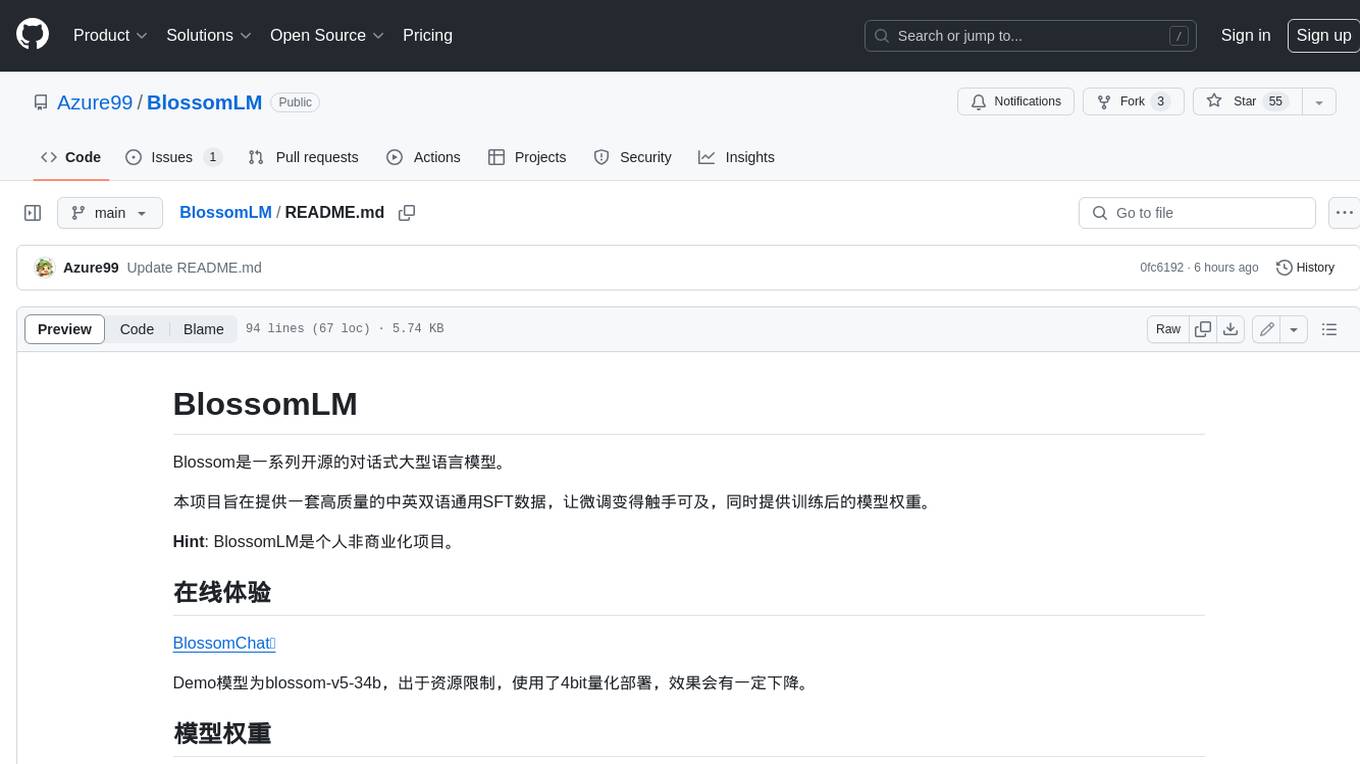
BlossomLM
BlossomLM is a series of open-source conversational large language models. This project aims to provide a high-quality general-purpose SFT dataset in both Chinese and English, making fine-tuning accessible while also providing pre-trained model weights. **Hint**: BlossomLM is a personal non-commercial project.
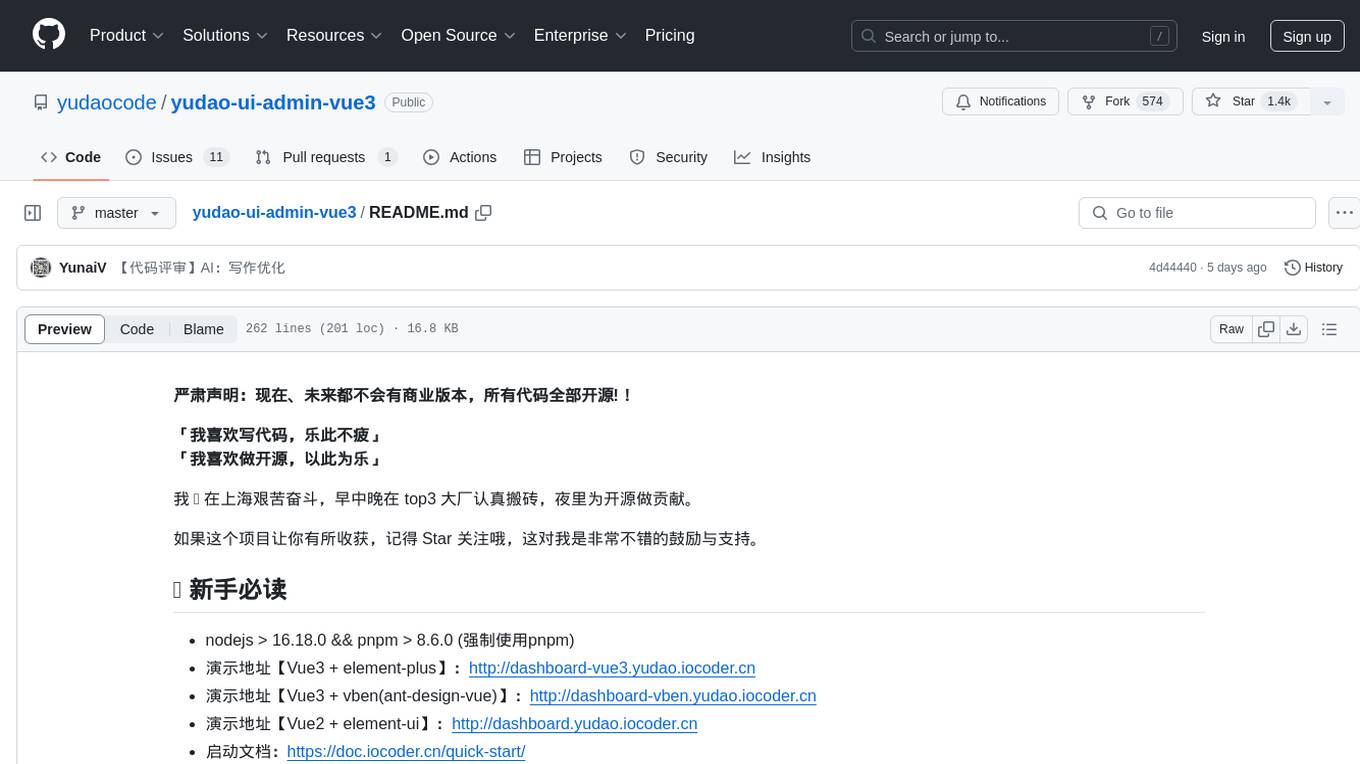
yudao-ui-admin-vue3
The yudao-ui-admin-vue3 repository is an open-source project focused on building a fast development platform for developers in China. It utilizes Vue3 and Element Plus to provide features such as configurable themes, internationalization, dynamic route permission generation, common component encapsulation, and rich examples. The project supports the latest front-end technologies like Vue3 and Vite4, and also includes tools like TypeScript, pinia, vueuse, vue-i18n, vue-router, unocss, iconify, and wangeditor. It offers a range of development tools and features for system functions, infrastructure, workflow management, payment systems, member centers, data reporting, e-commerce systems, WeChat public accounts, ERP systems, and CRM systems.
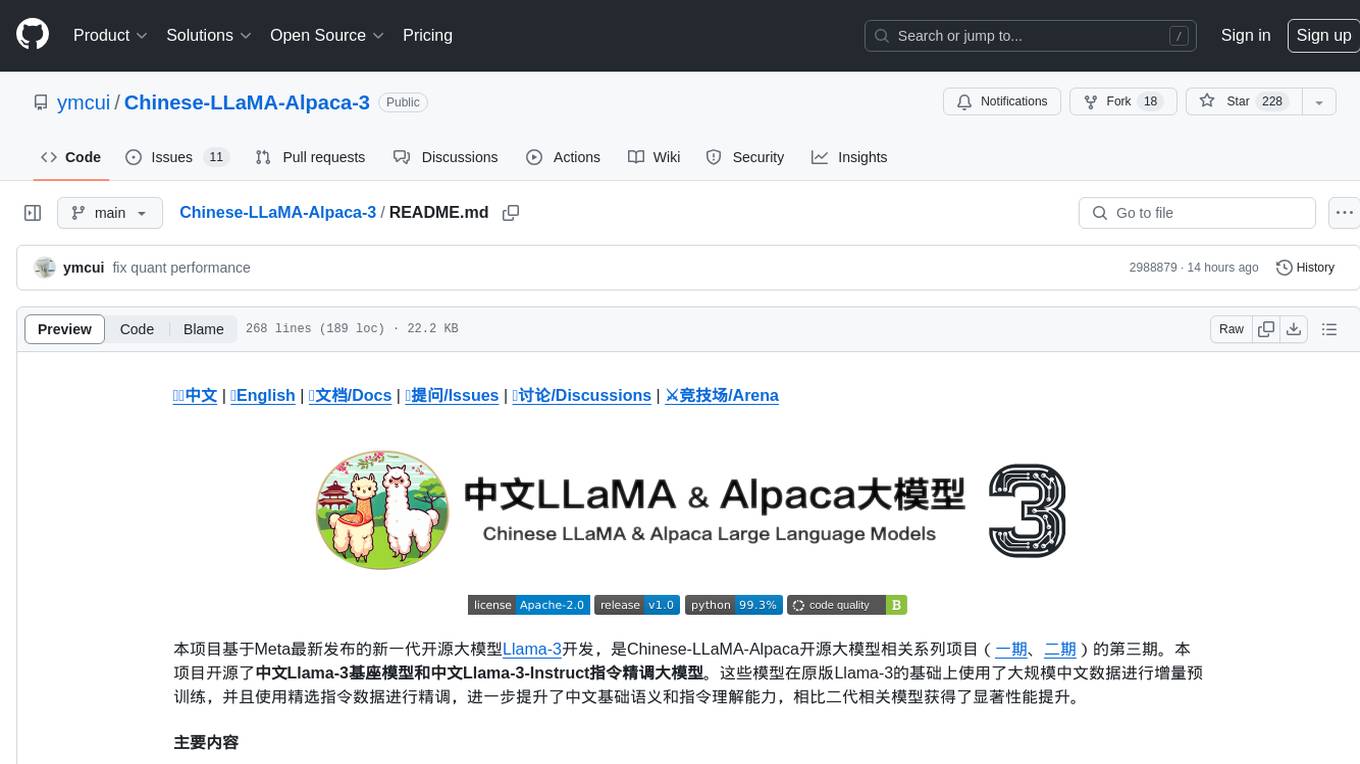
Chinese-LLaMA-Alpaca-3
Chinese-LLaMA-Alpaca-3 is a project based on Meta's latest release of the new generation open-source large model Llama-3. It is the third phase of the Chinese-LLaMA-Alpaca open-source large model series projects (Phase 1, Phase 2). This project open-sources the Chinese Llama-3 base model and the Chinese Llama-3-Instruct instruction fine-tuned large model. These models incrementally pre-train with a large amount of Chinese data on the basis of the original Llama-3 and further fine-tune using selected instruction data, enhancing Chinese basic semantics and instruction understanding capabilities. Compared to the second-generation related models, significant performance improvements have been achieved.
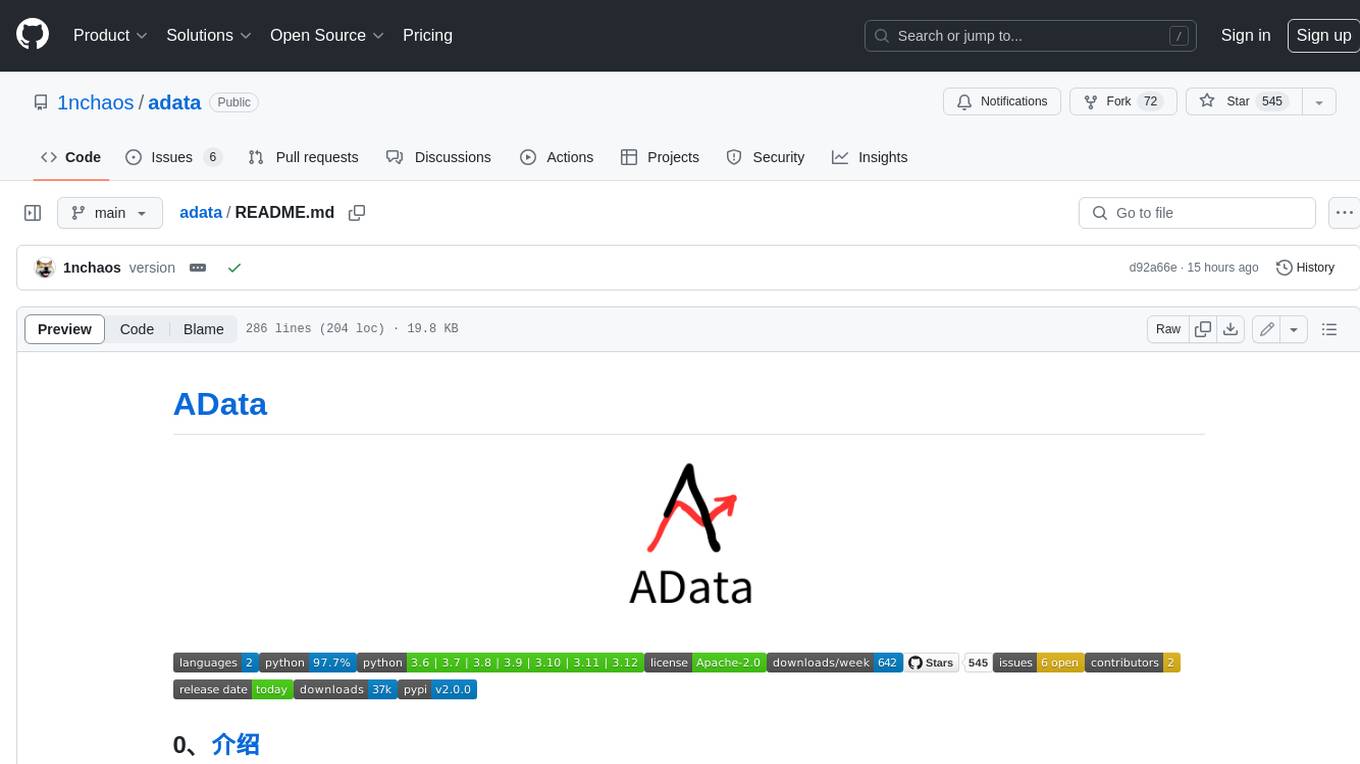
adata
AData is a free and open-source A-share database that focuses on transaction-related data. It provides comprehensive data on stocks, including basic information, market data, and sentiment analysis. AData is designed to be easy to use and integrate with other applications, making it a valuable tool for quantitative trading and AI training.
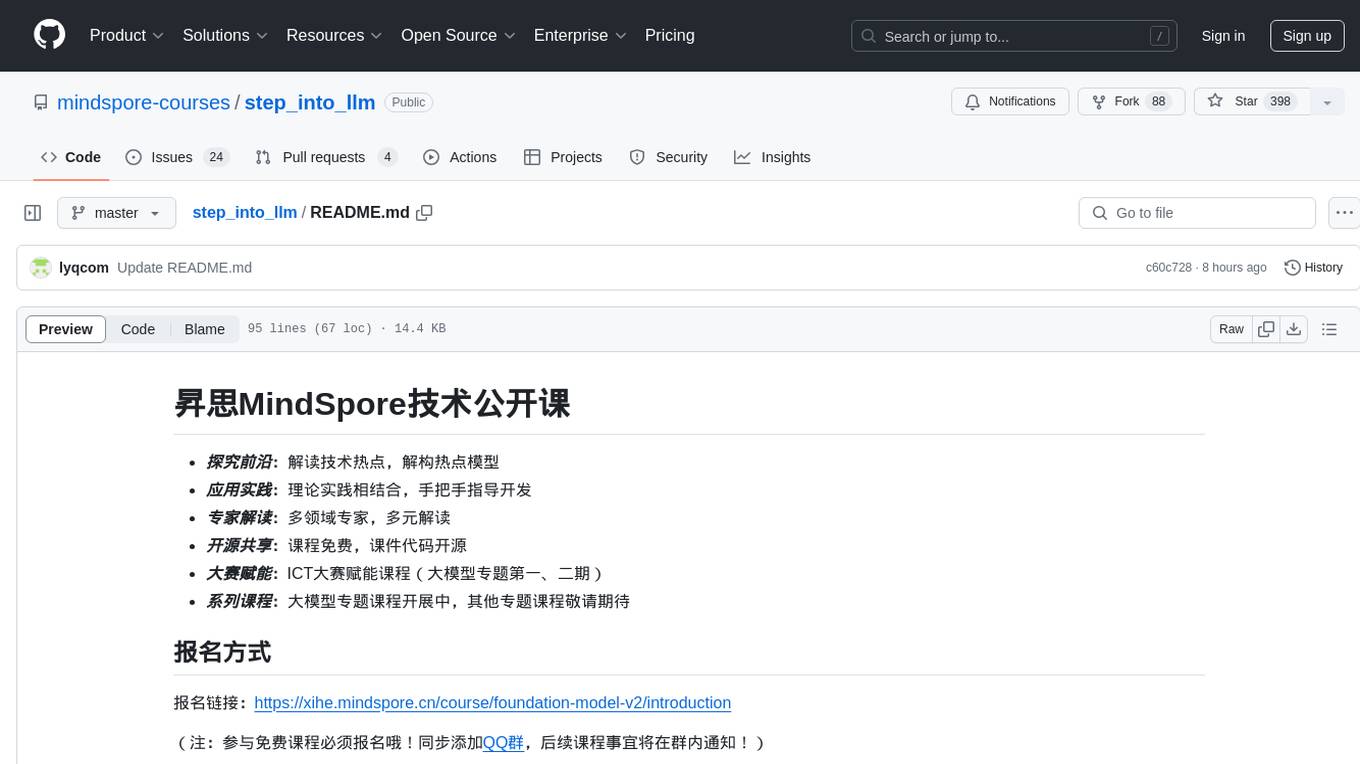
step_into_llm
The 'step_into_llm' repository is dedicated to the 昇思MindSpore technology open class, which focuses on exploring cutting-edge technologies, combining theory with practical applications, expert interpretations, open sharing, and empowering competitions. The repository contains course materials, including slides and code, for the ongoing second phase of the course. It covers various topics related to large language models (LLMs) such as Transformer, BERT, GPT, GPT2, and more. The course aims to guide developers interested in LLMs from theory to practical implementation, with a special emphasis on the development and application of large models.
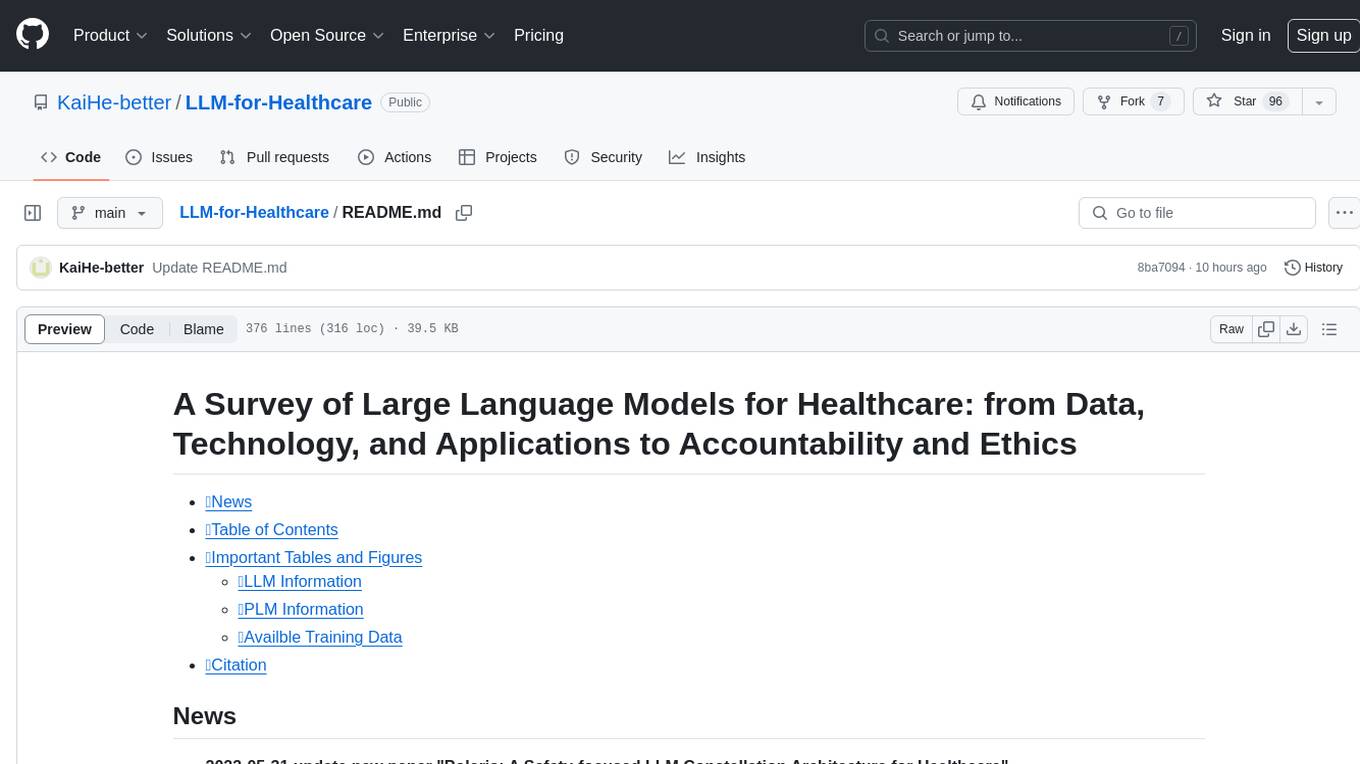
LLM-for-Healthcare
The repository 'LLM-for-Healthcare' provides a comprehensive survey of large language models (LLMs) for healthcare, covering data, technology, applications, and accountability and ethics. It includes information on various LLM models, training data, evaluation methods, and computation costs. The repository also discusses tasks such as NER, text classification, question answering, dialogue systems, and generation of medical reports from images in the healthcare domain.
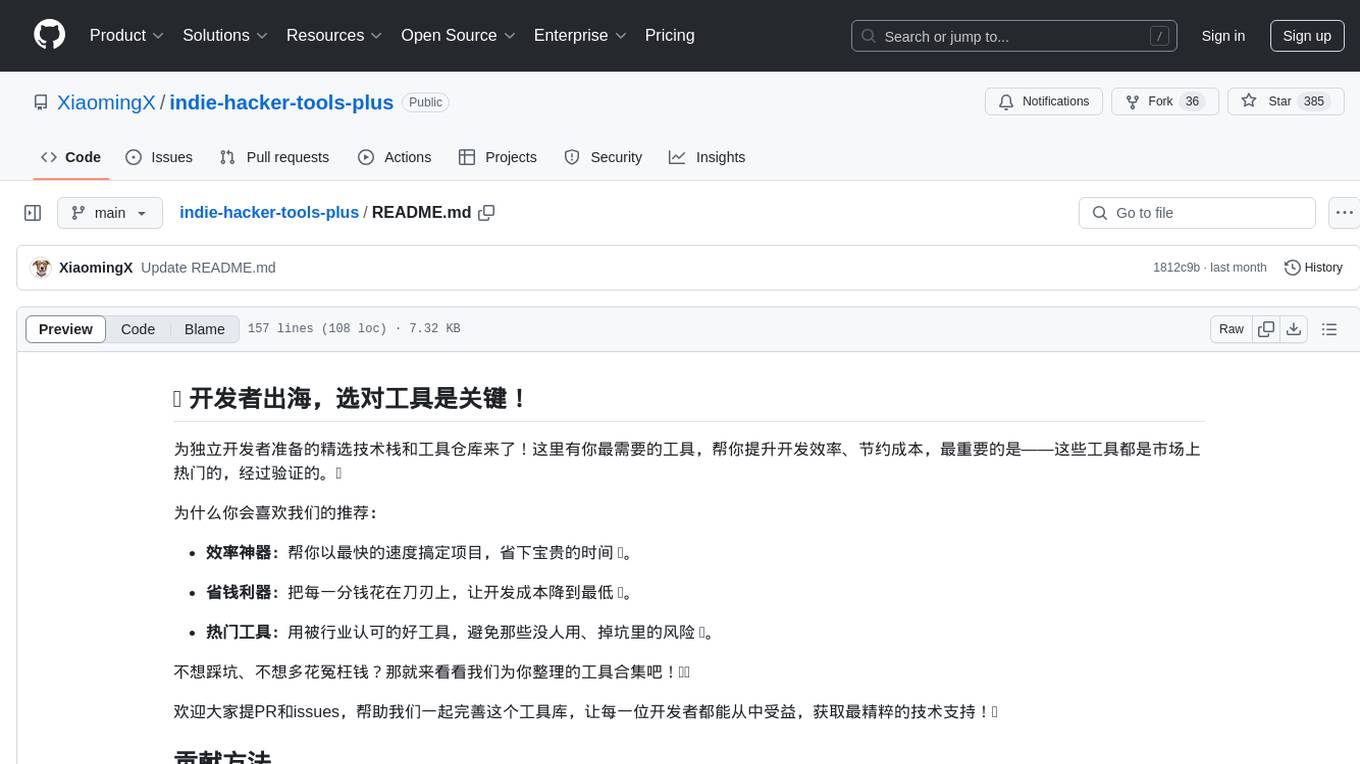
indie-hacker-tools-plus
Indie Hacker Tools Plus is a curated repository of essential tools and technology stacks for independent developers. The repository aims to help developers enhance efficiency, save costs, and mitigate risks by using popular and validated tools. It provides a collection of tools recognized by the industry to empower developers with the most refined technical support. Developers can contribute by submitting articles, software, or resources through issues or pull requests.
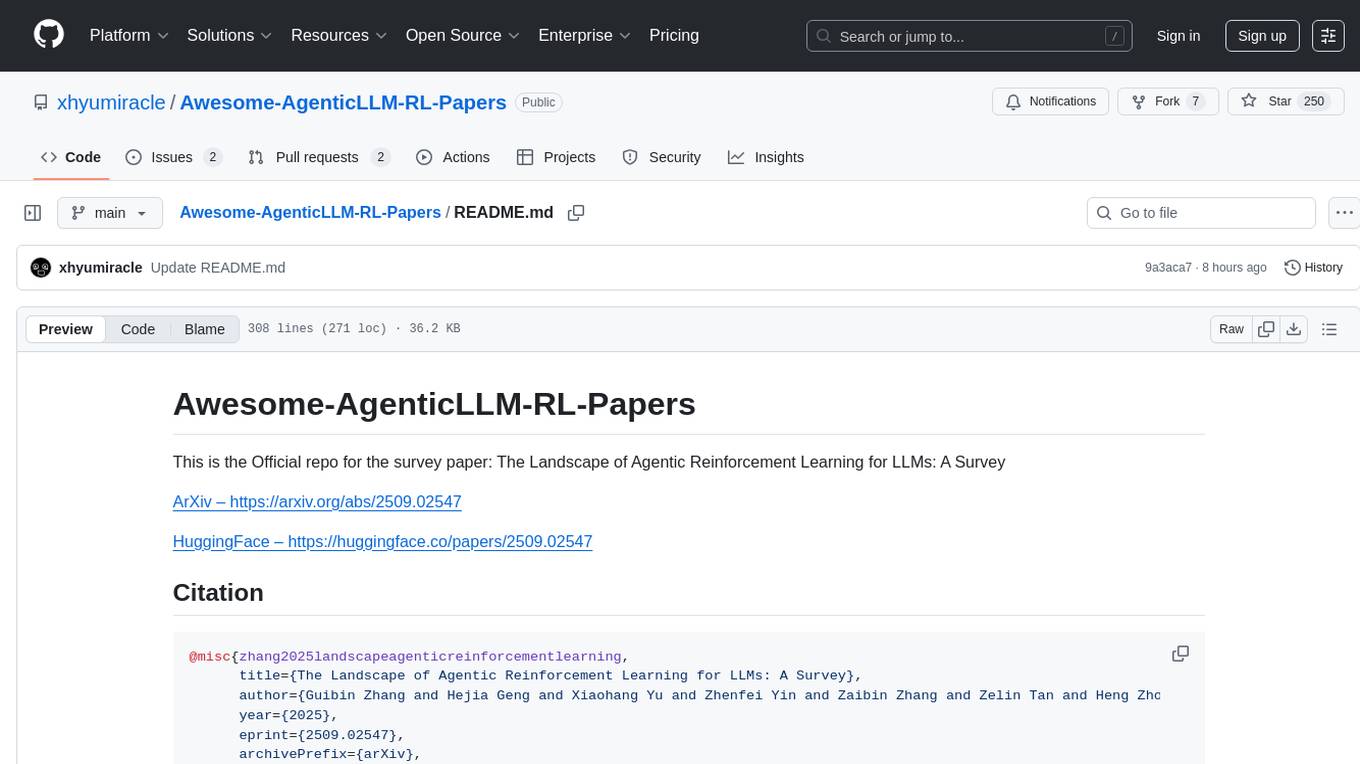
Awesome-AgenticLLM-RL-Papers
This repository serves as the official source for the survey paper 'The Landscape of Agentic Reinforcement Learning for LLMs: A Survey'. It provides an extensive overview of various algorithms, methods, and frameworks related to Agentic RL, including detailed information on different families of algorithms, their key mechanisms, objectives, and links to relevant papers and resources. The repository covers a wide range of tasks such as Search & Research Agent, Code Agent, Mathematical Agent, GUI Agent, RL in Vision Agents, RL in Embodied Agents, and RL in Multi-Agent Systems. Additionally, it includes information on environments, frameworks, and methods suitable for different tasks related to Agentic RL and LLMs.
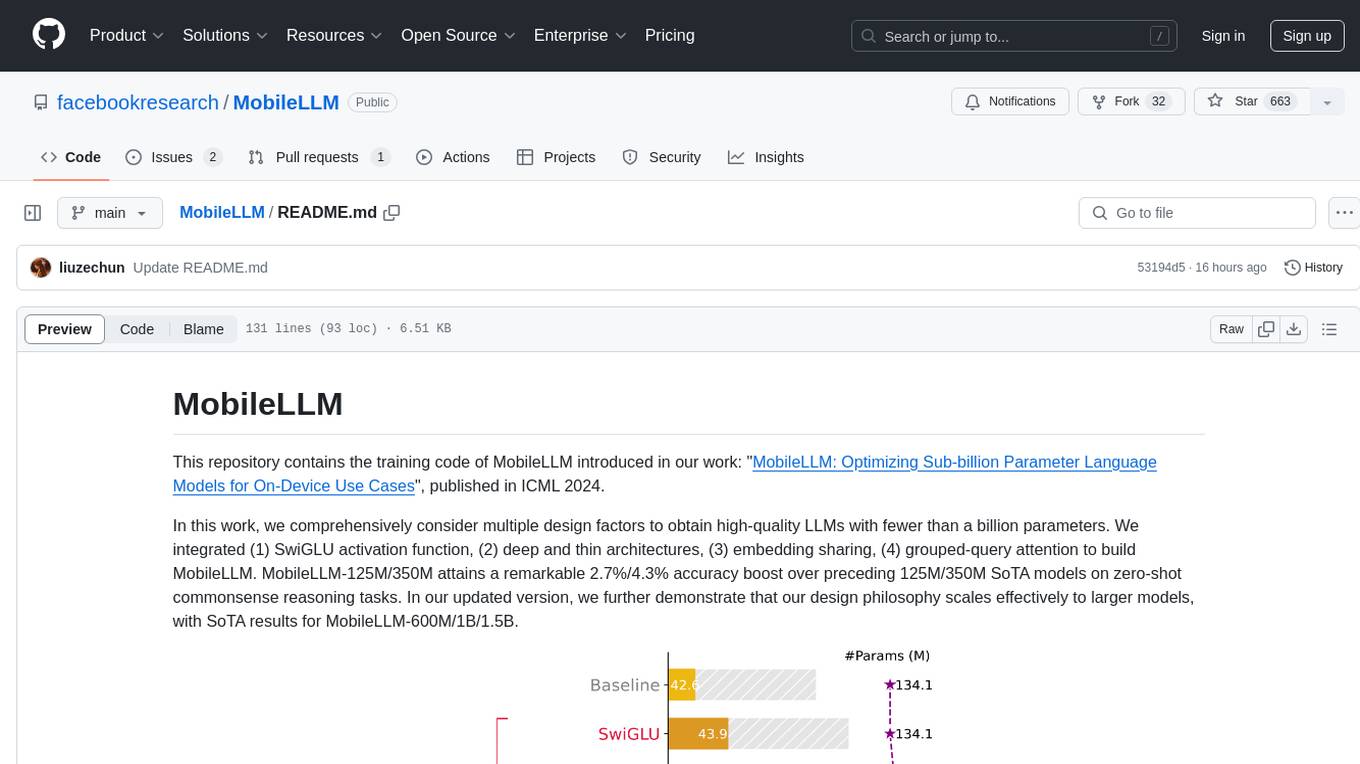
MobileLLM
This repository contains the training code of MobileLLM, a language model optimized for on-device use cases with fewer than a billion parameters. It integrates SwiGLU activation function, deep and thin architectures, embedding sharing, and grouped-query attention to achieve high-quality LLMs. MobileLLM-125M/350M shows significant accuracy improvements over previous models on zero-shot commonsense reasoning tasks. The design philosophy scales effectively to larger models, with state-of-the-art results for MobileLLM-600M/1B/1.5B.
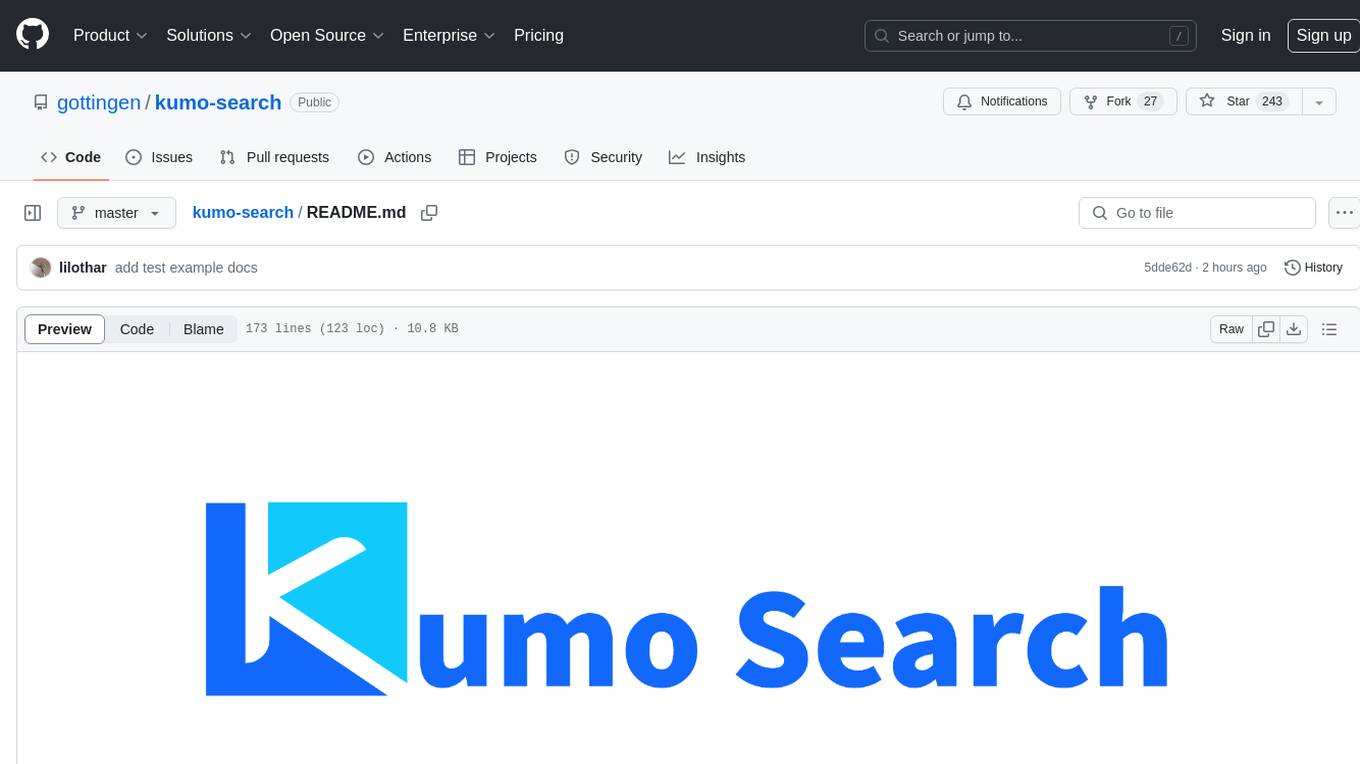
kumo-search
Kumo search is an end-to-end search engine framework that supports full-text search, inverted index, forward index, sorting, caching, hierarchical indexing, intervention system, feature collection, offline computation, storage system, and more. It runs on the EA (Elastic automic infrastructure architecture) platform, enabling engineering automation, service governance, real-time data, service degradation, and disaster recovery across multiple data centers and clusters. The framework aims to provide a ready-to-use search engine framework to help users quickly build their own search engines. Users can write business logic in Python using the AOT compiler in the project, which generates C++ code and binary dynamic libraries for rapid iteration of the search engine.
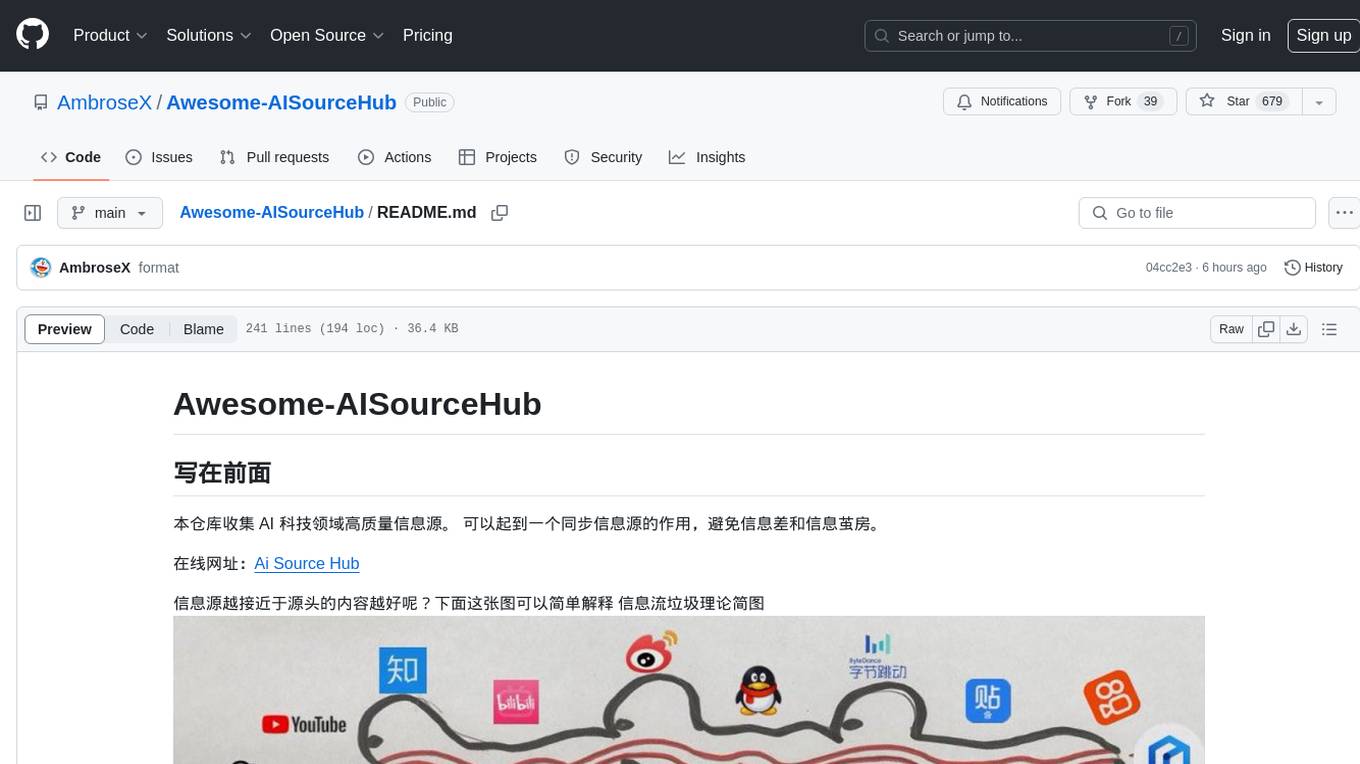
Awesome-AISourceHub
Awesome-AISourceHub is a repository that collects high-quality information sources in the field of AI technology. It serves as a synchronized source of information to avoid information gaps and information silos. The repository aims to provide valuable resources for individuals such as AI book authors, enterprise decision-makers, and tool developers who frequently use Twitter to share insights and updates related to AI advancements. The platform emphasizes the importance of accessing information closer to the source for better quality content. Users can contribute their own high-quality information sources to the repository by following specific steps outlined in the contribution guidelines. The repository covers various platforms such as Twitter, public accounts, knowledge planets, podcasts, blogs, websites, YouTube channels, and more, offering a comprehensive collection of AI-related resources for individuals interested in staying updated with the latest trends and developments in the AI field.
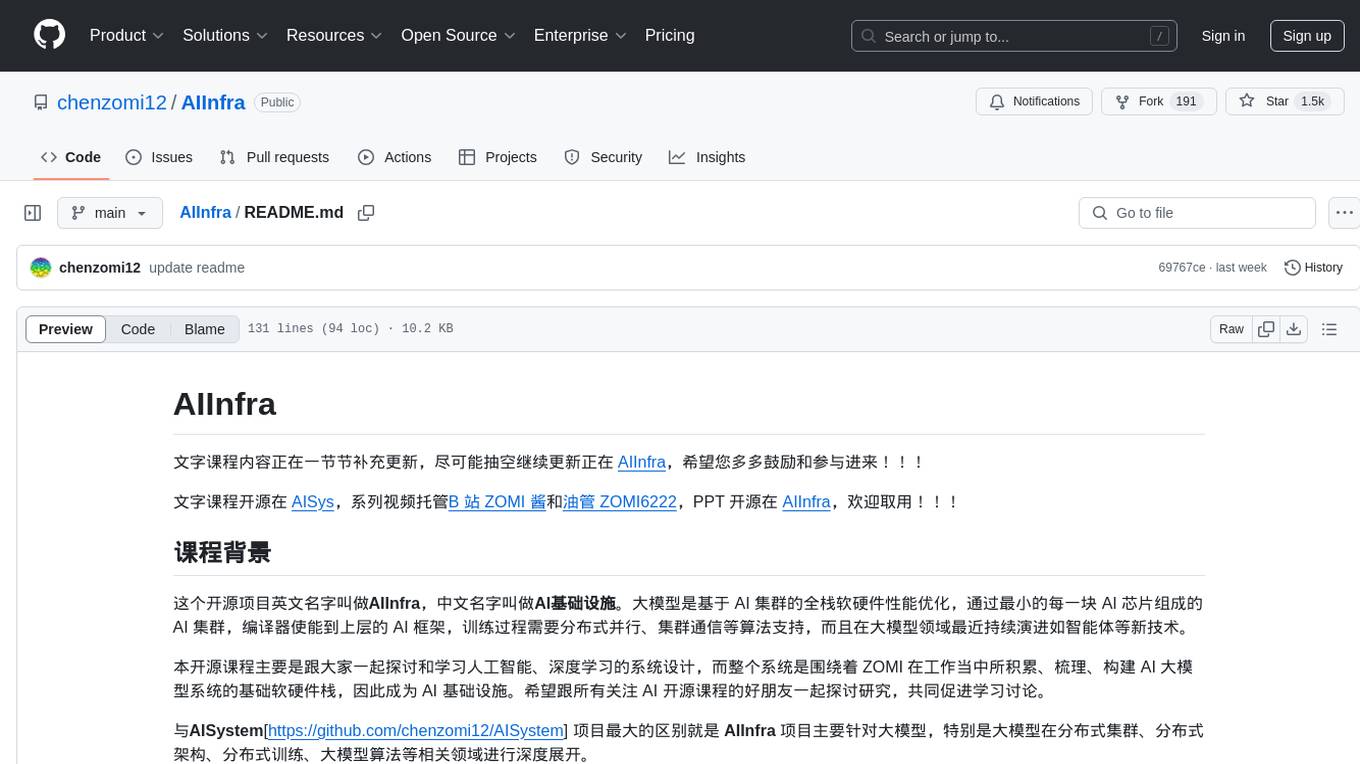
AIInfra
AIInfra is an open-source project focused on AI infrastructure, specifically targeting large models in distributed clusters, distributed architecture, distributed training, and algorithms related to large models. The project aims to explore and study system design in artificial intelligence and deep learning, with a focus on the hardware and software stack for building AI large model systems. It provides a comprehensive curriculum covering topics such as AI chip principles, communication and storage, AI clusters, large model training, and inference, as well as algorithms for large models. The course is designed for undergraduate and graduate students, as well as professionals working with AI large model systems, to gain a deep understanding of AI computer system architecture and design.
For similar tasks

PaddleScience
PaddleScience is a scientific computing suite developed based on the deep learning framework PaddlePaddle. It utilizes the learning ability of deep neural networks and the automatic (higher-order) differentiation mechanism of PaddlePaddle to solve problems in physics, chemistry, meteorology, and other fields. It supports three solving methods: physics mechanism-driven, data-driven, and mathematical fusion, and provides basic APIs and detailed documentation for users to use and further develop.
For similar jobs

PaddleScience
PaddleScience is a scientific computing suite developed based on the deep learning framework PaddlePaddle. It utilizes the learning ability of deep neural networks and the automatic (higher-order) differentiation mechanism of PaddlePaddle to solve problems in physics, chemistry, meteorology, and other fields. It supports three solving methods: physics mechanism-driven, data-driven, and mathematical fusion, and provides basic APIs and detailed documentation for users to use and further develop.
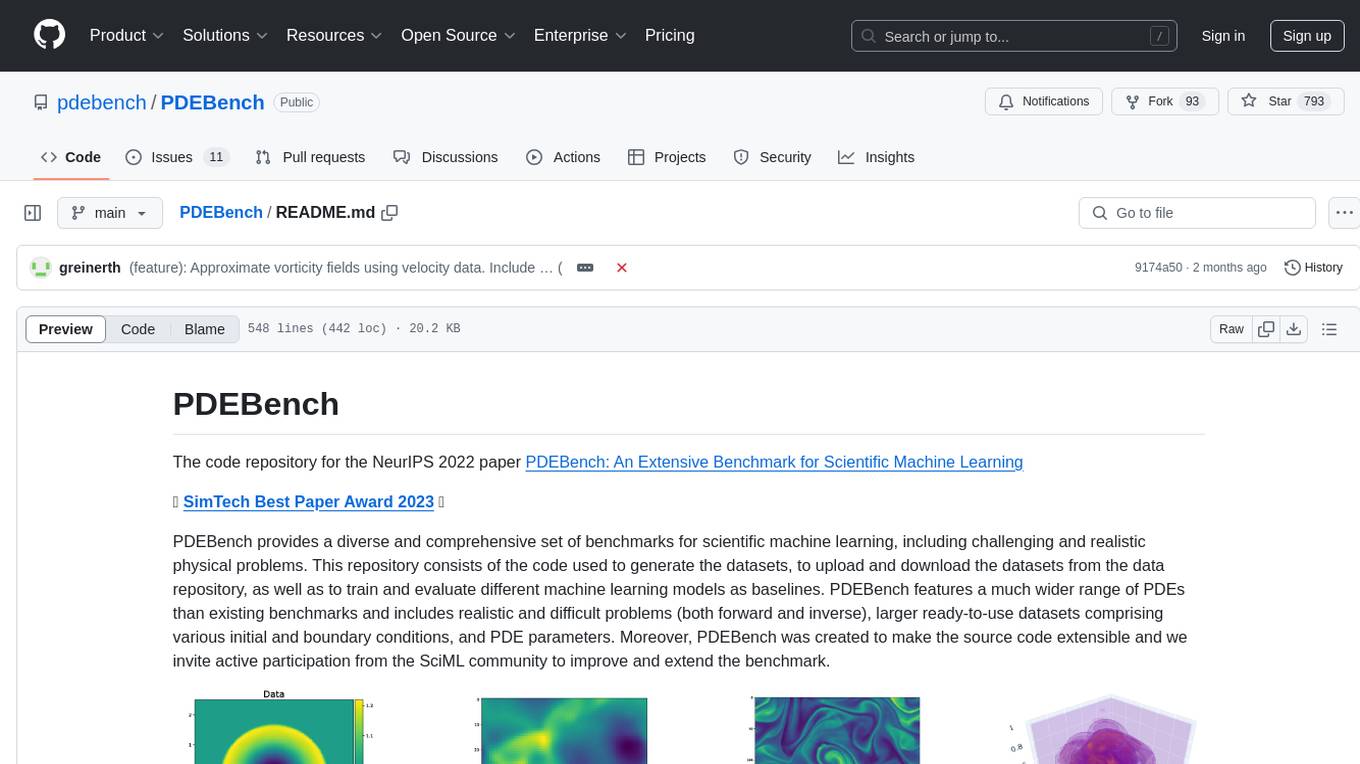
PDEBench
PDEBench provides a diverse and comprehensive set of benchmarks for scientific machine learning, including challenging and realistic physical problems. The repository consists of code for generating datasets, uploading and downloading datasets, training and evaluating machine learning models as baselines. It features a wide range of PDEs, realistic and difficult problems, ready-to-use datasets with various conditions and parameters. PDEBench aims for extensibility and invites participation from the SciML community to improve and extend the benchmark.

weave
Weave is a toolkit for developing Generative AI applications, built by Weights & Biases. With Weave, you can log and debug language model inputs, outputs, and traces; build rigorous, apples-to-apples evaluations for language model use cases; and organize all the information generated across the LLM workflow, from experimentation to evaluations to production. Weave aims to bring rigor, best-practices, and composability to the inherently experimental process of developing Generative AI software, without introducing cognitive overhead.

agentcloud
AgentCloud is an open-source platform that enables companies to build and deploy private LLM chat apps, empowering teams to securely interact with their data. It comprises three main components: Agent Backend, Webapp, and Vector Proxy. To run this project locally, clone the repository, install Docker, and start the services. The project is licensed under the GNU Affero General Public License, version 3 only. Contributions and feedback are welcome from the community.

oss-fuzz-gen
This framework generates fuzz targets for real-world `C`/`C++` projects with various Large Language Models (LLM) and benchmarks them via the `OSS-Fuzz` platform. It manages to successfully leverage LLMs to generate valid fuzz targets (which generate non-zero coverage increase) for 160 C/C++ projects. The maximum line coverage increase is 29% from the existing human-written targets.

LLMStack
LLMStack is a no-code platform for building generative AI agents, workflows, and chatbots. It allows users to connect their own data, internal tools, and GPT-powered models without any coding experience. LLMStack can be deployed to the cloud or on-premise and can be accessed via HTTP API or triggered from Slack or Discord.

VisionCraft
The VisionCraft API is a free API for using over 100 different AI models. From images to sound.

kaito
Kaito is an operator that automates the AI/ML inference model deployment in a Kubernetes cluster. It manages large model files using container images, avoids tuning deployment parameters to fit GPU hardware by providing preset configurations, auto-provisions GPU nodes based on model requirements, and hosts large model images in the public Microsoft Container Registry (MCR) if the license allows. Using Kaito, the workflow of onboarding large AI inference models in Kubernetes is largely simplified.







